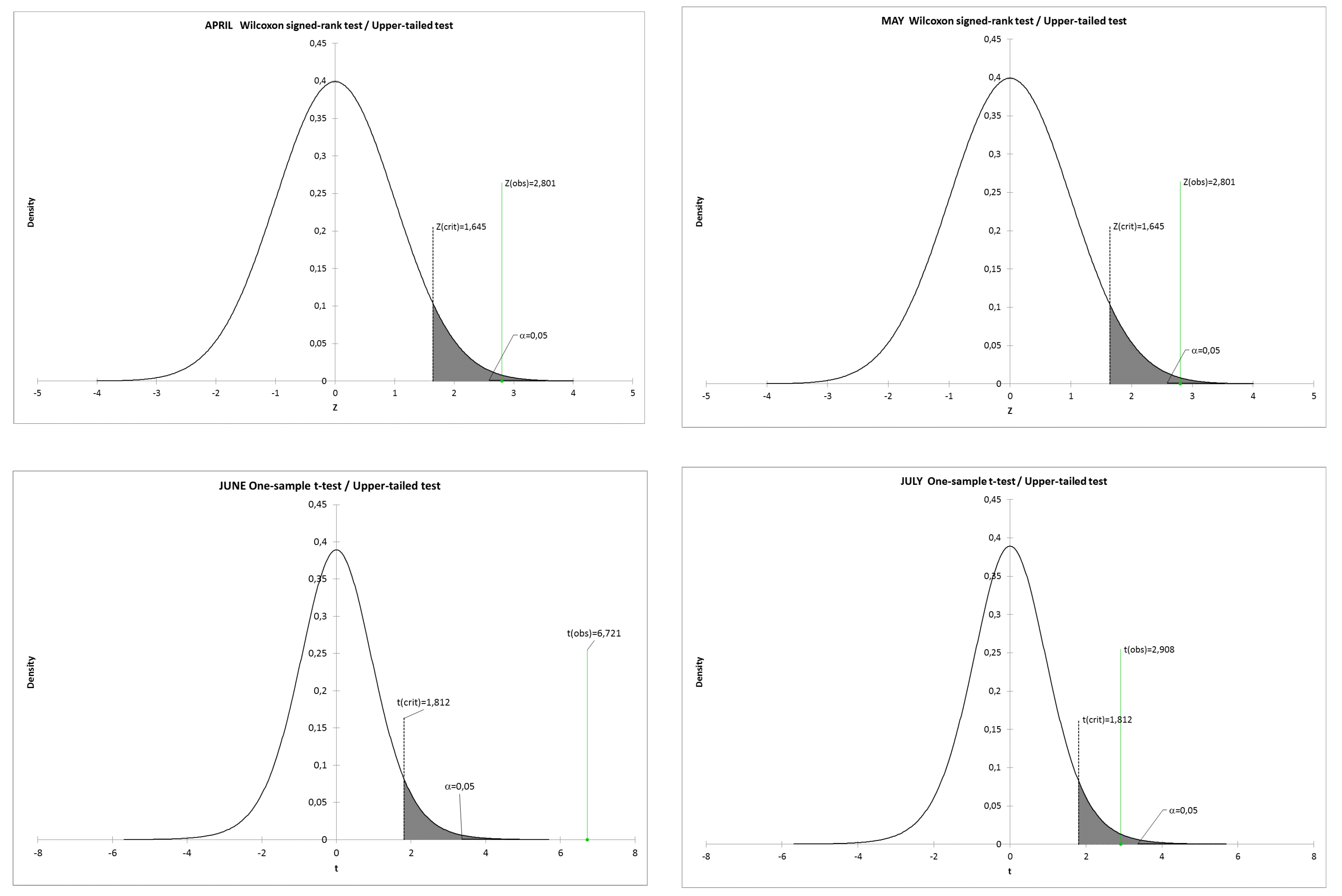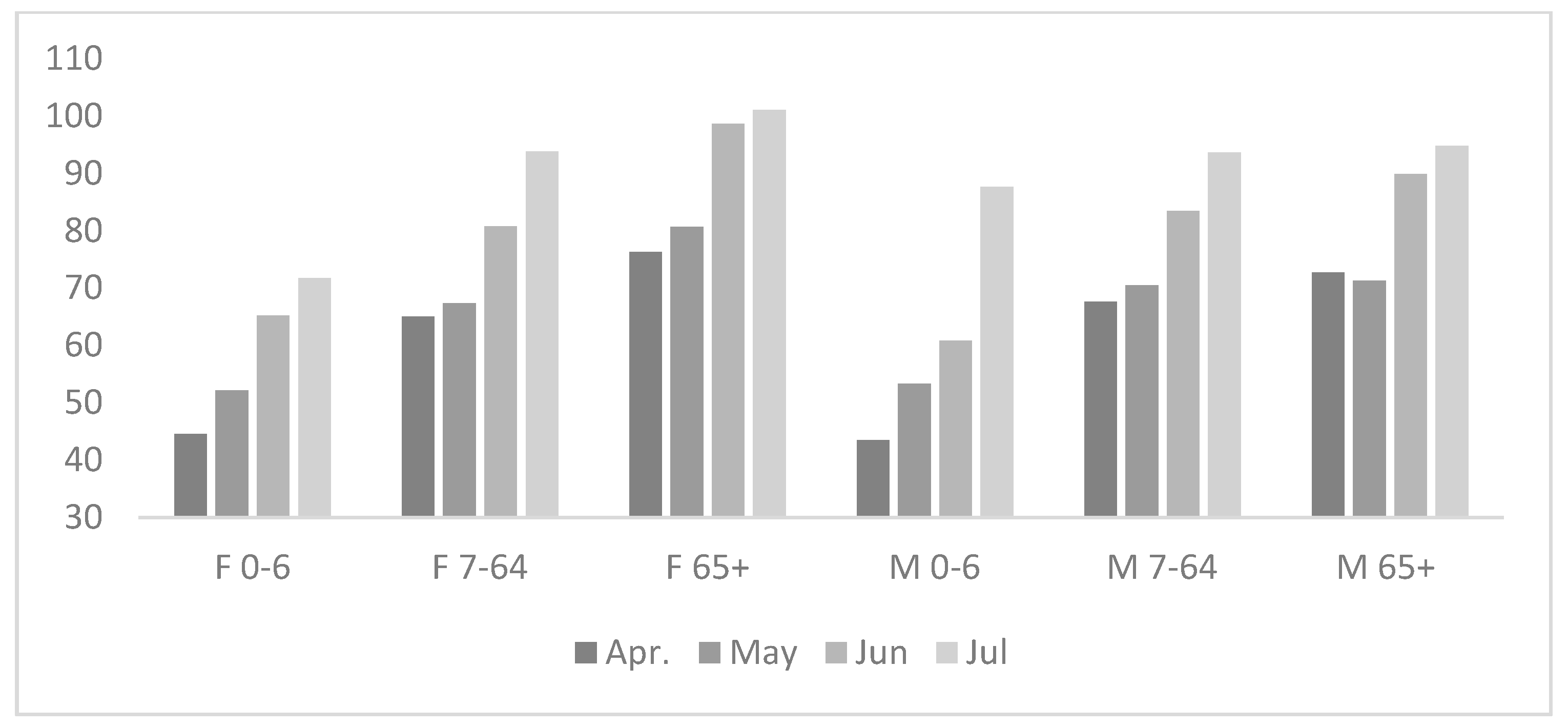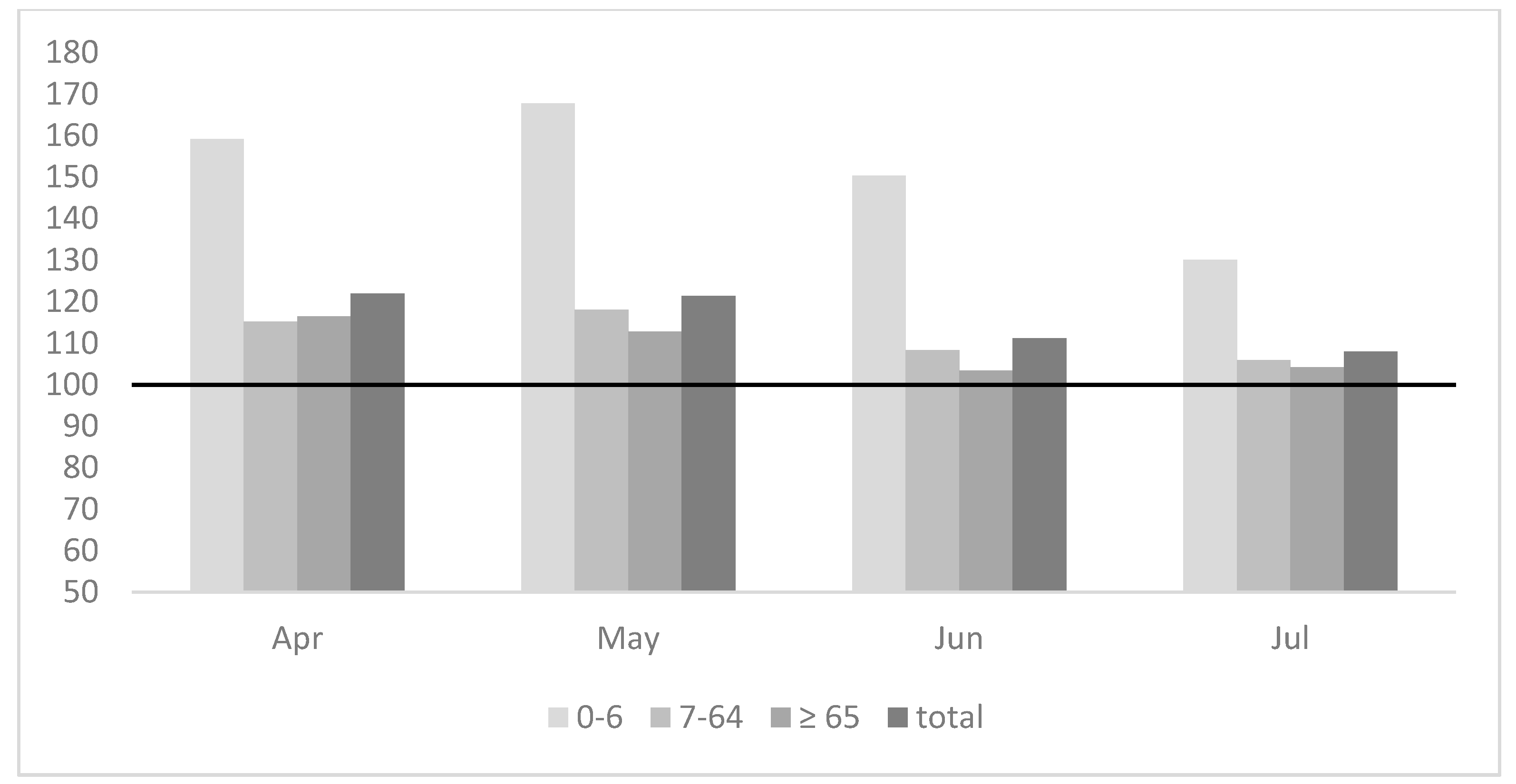Assessment of the Consultation Rate with General Practitioners in the Initial Phase of the COVID-19 Pandemic
Abstract
1. Introduction
2. Materials and Methods
Ethical Statement
3. Results
4. Discussion
5. Limitations
6. Conclusions
Author Contributions
Funding
Acknowledgments
Conflicts of Interest
References
- Li, Q.; Guan, X.; Wu, P.; Wang, X.; Zhou, L.; Tong, Y.; Ren, R.; Leung, K.S.; Lau, E.H.; Wong, J.Y. Early transmission dynamics in Wuhan, China, of novel coronavirus–infected pneumonia. N. Engl. J. Med. 2020, 382, 1199–1207. [Google Scholar] [CrossRef] [PubMed]
- Gujski, M.; Raciborski, F.; Jankowski, M.; Nowicka, P.M.; Rakocy, K.; Pinkas, J. Epidemiological Analysis of the First 1389 Cases of COVID-19 in Poland: A Preliminary Report. Med. Sci. Monit. Int. Med. J. Exp. Clin. Res. 2020, 26, e924702-1. [Google Scholar]
- Service of the Republic of Poland. Available online: https://www.gov.pl/web/koronawirus/wprowadzamy-stan-epidemii-w-polsce?fbclid=IwAR0frNr8PXW-JaX-xAJs4ViwGgyB6yCclvt-Ati2thuMamHL2UvUfdZ10rw (accessed on 30 August 2020).
- Service of the Republic of Poland. Available online: https://www.gov.pl/web/koronawirus/wykaz-zarazen-koronawirusem-sars-cov-2 (accessed on 30 August 2020).
- Bendau, A.; Petzold, M.B.; Pyrkosch, L.; Maricic, L.M.; Betzler, F.; Rogoll, J.; Große, J.; Ströhle, A.; Plag, J. Associations between COVID-19 related media consumption and symptoms of anxiety, depression and COVID-19 related fear in the general population in Germany. In European Archives of Psychiatry and Clinical Neuroscience; Springer: New York, NY, USA, 2020; pp. 1–9. [Google Scholar]
- Shimizu, K. 2019-nCoV, fake news, and racism. Lancet 2020, 395, 685–686. [Google Scholar] [CrossRef]
- Rovetta, A.; Bhagavathula, A.S. Covid-19-related web search behaviors and infodemic attitudes in italy: Infodemiological study. JMIR Public Health Surveill. 2020, 6, e19374. [Google Scholar] [CrossRef] [PubMed]
- Olivera-La Rosa, A.; Chuquichambi, E.G.; Ingram, G.P. Keep your (social) distance: Pathogen concerns and social perception in the time of COVID-19. Personal. Individ. Differ. 2020, 166, 110200. [Google Scholar] [CrossRef] [PubMed]
- Romaszko, J.; Skutecki, R.; Bocheński, M.; Cymes, I.; Dragańska, E.; Jastrzębski, P.; Morocka-Tralle, I.; Jalali, R.; Jeznach-Steinhagen, A.; Glińska-Lewczuk, K. Applicability of the universal thermal climate index for predicting the outbreaks of respiratory tract infections: A mathematical modeling approach. Int. J. Biometeorol. 2019, 63, 1231–1241. [Google Scholar] [CrossRef] [PubMed]
- Wang, C.; Pan, R.; Wan, X.; Tan, Y.; Xu, L.; McIntyre, R.S.; Choo, F.N.; Tran, B.; Ho, R.; Sharma, V.K. A longitudinal study on the mental health of general population during the COVID-19 epidemic in China. Brain Behav. Immun. 2020, 87, 40–48. [Google Scholar] [CrossRef]
- Gao, J.; Zheng, P.; Jia, Y.; Chen, H.; Mao, Y.; Chen, S.; Wang, Y.; Fu, H.; Dai, J. Mental health problems and social media exposure during COVID-19 outbreak. PLoS ONE 2020, 15, e0231924. [Google Scholar] [CrossRef]
- Yu, J.; Ouyang, W.; Chua, M.L.; Xie, C. SARS-CoV-2 transmission in patients with cancer at a tertiary care hospital in Wuhan, China. JAMA Oncol. 2020, 6, 1108–1110. [Google Scholar] [CrossRef]
- Chou, R.; Dana, T.; Buckley, D.I.; Selph, S.; Fu, R.; Totten, A.M. Epidemiology of and risk factors for coronavirus infection in health care workers: A living rapid review. Ann. Intern. Med. 2020, 173, 120–136. [Google Scholar] [CrossRef]
- Cabas, P.; Di Bella, S.; Giuffre, M.; Rizzo, M.; Trombetta, C.; Luzzati, R.; Antonello, R.M.; Parenzan, K.; Liguori, G. Community pharmacists’ exposure to COVID-19. Res. Soc. Adm. Pharm. 2020, 17, E69. [Google Scholar] [CrossRef] [PubMed]
- Chan, L.Y.; Wong, J.T.; Li, P.K.; Lui, S.F.; Fung, H.; Sung, J. Risk of transmission of severe acute respiratory syndrome to household contacts by infected health care workers and patients. Am. J. Med. 2004, 116, 559–560. [Google Scholar] [CrossRef]
- Romaszko, J.; Romaszko, E.; Buciński, A. Reforma, czyli POZ w ślepej uliczce. Lek. Rodz. 2003, 3, 248–252. [Google Scholar]
- World Health Organization. International Statistical Classification of Diseases and Related Health Problems; World Health Organization: Geneva, Switzerland, 2004; Volume 1. [Google Scholar]
- Paddison, C.A.; Abel, G.A.; Roland, M.O.; Elliott, M.N.; Lyratzopoulos, G.; Campbell, J.L. Drivers of overall satisfaction with primary care: Evidence from the English General Practice Patient Survey. Health Expect. 2015, 18, 1081–1092. [Google Scholar] [CrossRef] [PubMed]
- Romaszko, E.; Buciński, A.; Skokowska, A.; Matuszewski, J. Obcia̧żenie praca̧ w podstawowej opiece zdrowotnej-Analiza zgłaszalności w zależności od wieku i płci pacjenta. Pediatr. Med. Rodz. 2007, 3, 48–52. [Google Scholar]
- Wang, L.; He, W.; Yu, X.; Hu, D.; Bao, M.; Liu, H.; Zhou, J.; Jiang, H. Coronavirus disease 2019 in elderly patients: Characteristics and prognostic factors based on 4-week follow-up. J. Infect. 2020, 80, 639–645. [Google Scholar] [CrossRef]
- Bujnowska-Fedak, M.M.; Grata-Borkowska, U. Use of telemedicine-based care for the aging and elderly: Promises and pitfalls. Smart Homecare Technol. TeleHealth 2015, 3, 91–105. [Google Scholar] [CrossRef]
- Clark, J.; McGee-Lennon, M. A stakeholder-centred exploration of the current barriers to the uptake of home care technology in the UK. J. Assist. Technol. 2011, 5, 12–25. [Google Scholar] [CrossRef]
- Ten Bruggencate, T.; Luijkx, K.G.; Sturm, J. Social needs of older people: A systematic literature review. Ageing Soc. 2018, 38, 1745–1770. [Google Scholar] [CrossRef]
- Wessing, I.; Platzbecker, F.; Dehghan-Nayyeri, M.; Romer, G.; Pfleiderer, B. Maternal perception of children’s fear: A fMRI study in mothers of preschool children. Soc. Neurosci. 2019, 14, 739–750. [Google Scholar] [CrossRef]
- Yuan, R.; Xu, Q.-h.; Xia, C.-C.; Lou, C.-y.; Xie, Z.; Ge, Q.-M.; Shao, Y. Psychological status of parents of hospitalized children during the COVID-19 epidemic in China. Psychiatry Res. 2020, 288, 112953. [Google Scholar] [CrossRef] [PubMed]
- Kai, J. What worries parents when their preschool children are acutely ill, and why: A qualitative study. BMJ 1996, 313, 983–986. [Google Scholar] [CrossRef] [PubMed]
- Noriuchi, M.; Kikuchi, Y.; Senoo, A. The functional neuroanatomy of maternal love: Mother’s response to infant’s attachment behaviors. Biol. Psychiatry 2008, 63, 415–423. [Google Scholar] [CrossRef] [PubMed]
- Barrett, J.; Wonch, K.E.; Gonzalez, A.; Ali, N.; Steiner, M.; Hall, G.B.; Fleming, A.S. Maternal affect and quality of parenting experiences are related to amygdala response to infant faces. Soc. Neurosci. 2012, 7, 252–268. [Google Scholar] [CrossRef]
- Pavone, P.; Ceccarelli, M.; Taibi, R.; La Rocca, G.; Nunnari, G. Outbreak of COVID-19 infection in children: Fear and serenity. Eur. Rev. Med. Pharmacol. Sci. 2020, 24, 4572–4575. [Google Scholar]
- Lu, X.; Zhang, L.; Du, H.; Zhang, J.; Li, Y.Y.; Qu, J.; Zhang, W.; Wang, Y.; Bao, S.; Li, Y. SARS-CoV-2 infection in children. N. Engl. J. Med. 2020, 382, 1663–1665. [Google Scholar] [CrossRef]
- Ludvigsson, J.F. Systematic review of COVID-19 in children shows milder cases and a better prognosis than adults. Acta Paediatr. 2020, 109, 1088–1095. [Google Scholar] [CrossRef]
- Bialek, S.; Gierke, R.; Hughes, M.; McNamara, L.A.; Pilishvili, T.; Skoff, T. Coronavirus Disease 2019 in Children—United States, February 12–April 2, 2020. Morb. Mortal. Wkly. Rep. 2020, 69, 422. [Google Scholar]
- North, F.; Varkey, P.; Bartel, G.A.; Cox, D.L.; Jensen, P.L.; Stroebel, R.J. Can an office practice telephonic response meet the needs of a pandemic? Telemed. E-Health 2010, 16, 1012–1016. [Google Scholar] [CrossRef]



| Test | Upper-Tailed Wilcoxon Signed-Rank Test (Nonparametric Test) | Upper-Tailed One-Sample t-Test (Parametric Test) | ||
|---|---|---|---|---|
| Month | April | May | June | July |
| No of observations (Years 2010–2019) | 11 | 11 | 11 | 11 |
| Min. | 0.268 | 0.268 | 0.322 | 0.334 |
| Max. | 0.424 | 0.413 | 0.407 | 0.412 |
| Observed median/mean Mo | 0.388 | 0.371 | 0.372 | 0.359 |
| Std. deviation σ | 0.043 | 0.038 | 0.026 | 0.022 |
| Theoretical median/mean for 2020 Mt | 0.270 | 0.270 | 0.320 | 0.340 |
| Difference Mo–Mt | 0.118 | 0.101 | 0.052 | 0.019 |
| 95% confidence interval on the median/mean | [0.378; +∞) | [0.364; +∞) | [0.358; + ∞) | [0.347; +∞) |
| V | 65 | 65 | ||
| Z | 2.801 | 2.801 | ||
| t (Critical value) | 1.645 | 1.645 | 1.812 | 1.812 |
| t (Observed value) | 6.721 | 2.908 | ||
| df | 10 | 10 | 10 | 10 |
| p-value (one-tailed) | 0.003 | 0.003 | <0.001 | 0.008 |
| Change in the consultation rate * | 66.93 | 70.31 | 85.35 | 94.13 |
| Poland | Warmian–Masurian Region | |||
|---|---|---|---|---|
| Date | New Cases | All Cases | New Cases | All Cases |
| 01 April 2020 | 256 | 3211 | 3 | 61 |
| 10 April 2020 | 370 | 5575 | 15 | 110 |
| 20 April 2020 | 545 | 9278 | 1 | 143 |
| 30 April 2020 | 422 | 12,640 | 2 | 146 |
| 01 April 2020 | 239 | 34,393 | 6 | 250 |
| 10 April 2020 | 262 | 36,951 | 2 | 280 |
| 20 April 2020 | 358 | 40,104 | 4 | 298 |
| 30 April 2020 | 512 | 44,416 | 5 | 353 |
Publisher’s Note: MDPI stays neutral with regard to jurisdictional claims in published maps and institutional affiliations. |
© 2020 by the authors. Licensee MDPI, Basel, Switzerland. This article is an open access article distributed under the terms and conditions of the Creative Commons Attribution (CC BY) license (http://creativecommons.org/licenses/by/4.0/).
Share and Cite
Ochal, M.; Romaszko, M.; Glińska-Lewczuk, K.; Gromadziński, L.; Romaszko, J. Assessment of the Consultation Rate with General Practitioners in the Initial Phase of the COVID-19 Pandemic. Int. J. Environ. Res. Public Health 2020, 17, 7710. https://doi.org/10.3390/ijerph17217710
Ochal M, Romaszko M, Glińska-Lewczuk K, Gromadziński L, Romaszko J. Assessment of the Consultation Rate with General Practitioners in the Initial Phase of the COVID-19 Pandemic. International Journal of Environmental Research and Public Health. 2020; 17(21):7710. https://doi.org/10.3390/ijerph17217710
Chicago/Turabian StyleOchal, Michał, Małgorzata Romaszko, Katarzyna Glińska-Lewczuk, Leszek Gromadziński, and Jerzy Romaszko. 2020. "Assessment of the Consultation Rate with General Practitioners in the Initial Phase of the COVID-19 Pandemic" International Journal of Environmental Research and Public Health 17, no. 21: 7710. https://doi.org/10.3390/ijerph17217710
APA StyleOchal, M., Romaszko, M., Glińska-Lewczuk, K., Gromadziński, L., & Romaszko, J. (2020). Assessment of the Consultation Rate with General Practitioners in the Initial Phase of the COVID-19 Pandemic. International Journal of Environmental Research and Public Health, 17(21), 7710. https://doi.org/10.3390/ijerph17217710







